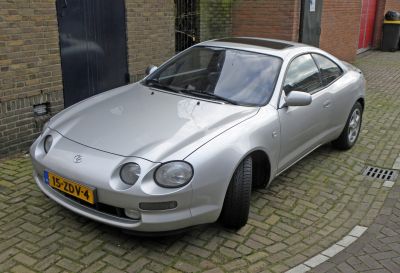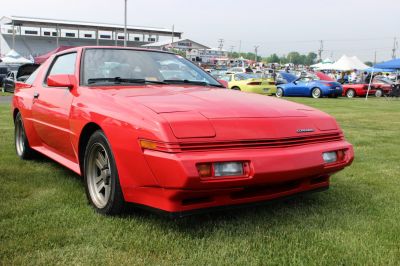 1997 Mitsubishi Eclipse II (2G, facelift 1997) Dimensions, Size & Specs
1997 Mitsubishi Eclipse II (2G, facelift 1997) Dimensions, Size & SpecsMeasurements of the 1997 Mitsubishi Eclipse II, engineered for optimal performance and comfort
| Dimensions | |
|---|---|
| Length: | 4385 mm172.6 in14.4 ft |
| Width: | 1745 mm68.7 in5.7 ft |
| Height: | 1295 mm51.0 in4.2 ft |
| Ground Clearance: | 145 mm5.7 in0.5 ft |
| Trunk Capacity: | 241 liter8.5 cu ft |
| Weight Specifications | |
| Curb Weight: | 1395 kg3075 lbs |
| Maximal permitted Weight: | 1750 kg3858 lbs |
| Roof Load: | 50 kg110 lbs |
| Tire Specifications | |
| Rims Size: | 15-inch rims:
|
| Tire Size: |
|
The Mitsubishi Eclipse II (2G facelift model from 1997 to 1999) is a compact sports car available in coupe and hatchback body styles. With a length of 4385 mm (172.6 inches), a width of 1745 mm (68.7 inches), and a height of 1295 mm (51.0 inches), this generation of Eclipse showcases a sleek and aerodynamic profile suited for sporty performance and urban driving. The vehicle's curb weight is 1395 kg (3074 lbs), allowing for nimble handling and an engaging driving experience while the maximum permissible weight reaches 1750 kg (3858 lbs). It offers a moderate ground clearance of 145 mm (5.7 inches), balancing sporty stance with practical usability on various road surfaces. Riding on 6J x 15 rims wrapped in 205/60 R15 tires, the Eclipse II achieves a combination of grip and comfort. Storage capacity includes a luggage volume of 241 liters (8.5 cubic feet), suitable for daily commuting or small road trips, with a roof load capacity rated at 50 kg (110 lbs) for additional cargo flexibility. This 2nd generation Mitsubishi Eclipse facelift model remains a popular choice among enthusiasts looking for a compact, stylish coupe or hatchback with balanced dimensions and sporting characteristics.
Discover the standout features that make the 1997 Mitsubishi Eclipse II a leader in its class
Have a question? Please check our knowledgebase first.
The Mitsubishi Eclipse II (2G facelift 1997) has an overall length of 4385 mm (172.6 inches), a width of 1745 mm (68.7 inches), and a height of 1295 mm (51 inches). These dimensions reflect the compact sporty coupe and hatchback design of the vehicle during its production from 1997 to 1999. The relatively low height gives it a sleek profile, while the width contributes to its stable handling on the road.
The curb weight of the Mitsubishi Eclipse II (2G facelift 1997) is 1395 kg (3074 lbs), which is the weight of the car without occupants or cargo but with all standard equipment and fluids. The maximum weight—also known as gross vehicle weight rating (GVWR)—is 1750 kg (3858 lbs), representing the maximum loaded weight that includes passengers, fuel, cargo, and accessories. This weight balance ensures a sporty yet manageable driving experience typical of late 90s coupes.
The luggage capacity of the Mitsubishi Eclipse II (2G facelift 1997) is 241 liters (approximately 8.5 cubic feet). This space is modest and typical for a sporty compact coupe or hatchback of its era. It is suitable for everyday needs such as groceries, small luggage, or gym gear, but may be limited for larger cargo or extensive road trips without folding rear seats or additional storage solutions.
Yes, the Mitsubishi Eclipse II (2G facelift 1997) fits comfortably in a standard residential garage. With its length of 4385 mm (172.6 inches) and width of 1745 mm (68.7 inches), it is compact enough to allow space around the vehicle for opening doors and moving around. Typical garages are about 2400-3000 mm (94-118 inches) wide and over 5000 mm (196 inches) deep, so the Eclipse's dimensions make it a convenient fit for most home garages.
The Mitsubishi Eclipse II (2G facelift 1997) has a ride height or ground clearance of 145 mm (5.7 inches). This relatively low clearance enhances stability and handling by lowering the center of gravity, which is beneficial for sporty performance and cornering. However, it also means the vehicle may be less suited for rough terrain or roads with large speed bumps, as the undercarriage could be more vulnerable to scrapes.
The Mitsubishi Eclipse II (2G facelift 1997) comes equipped with rims sized 6J x 15, paired with tires sized 205/60 R15. These 15-inch wheels and tire dimensions provide a balanced combination of sporty styling, ride comfort, and handling. The 205 mm width of the tire ensures decent road grip, while the 60 percent aspect ratio keeps sidewall height moderate for comfort without sacrificing responsive steering.
Compared to the first generation Mitsubishi Eclipse, the 1997 facelift of the second generation Eclipse (2G) is slightly longer and wider, enhancing interior space and road presence. The facelift maintained many design cues but refined aerodynamics and styling for better performance and aesthetics. The increased dimensions translate to modest improvements in passenger comfort and cargo capacity without losing the sporty feel.
The Mitsubishi Eclipse II (2G facelift 1997) measures 4385 mm in length and weighs 1395 kg curb weight, situating it well among late 1990s sporty coupes like the Honda Prelude and Toyota Celica. Its dimensions and weight offer a balanced mix of performance and maneuverability, slightly heavier than some rivals but compensating with a solid chassis and engine options. It remains a competitive choice in terms of size and sporty appeal.
The Mitsubishi Eclipse II facelift (1997-1999) was produced in both coupe and hatchback body styles. The coupe offers a sleeker roofline and sporty appearance, while the hatchback version provides slightly more versatility with rear cargo access and often a bit more rear seat headroom. The hatchback's design typically enhances practicality by allowing larger or irregularly shaped items with foldable rear seats, whereas the coupe focuses more on style and driving experience.
The Mitsubishi Eclipse II (2G facelift 1997) has a maximum roof load capacity of 50 kg (approximately 110 lbs). This load rating allows for the safe installation of roof racks or carriers for items such as luggage boxes, bicycles, or sporting equipment. However, it is important to stay within this weight limit to avoid damage to the roof structure and to maintain safe handling characteristics of the vehicle.
Discover similar sized cars.

| Production: | 1993-1999 |
|---|---|
| Model Year: | 1994 |
| Length: | 4425 mm174.2 in |
| Width: | 1750 mm68.9 in |
| Height: | 1305 mm51.4 in |

| Production: | 1986-1989 |
|---|---|
| Model Year: | 1983 |
| Length: | 4399 mm173.2 in |
| Width: | 1735 mm68.3 in |
| Height: | 1275 mm50.2 in |

| Production: | 1995-1996 |
|---|---|
| Model Year: | 1995 |
| Length: | 4375 mm172.2 in |
| Width: | 1735-1745 mm68.3-68.7 in |
| Height: | 1295 mm51.0 in |

| Production: | 1995-1996 |
|---|---|
| Model Year: | 1995 |
| Length: | 4375 mm172.2 in |
| Width: | 1735-1745 mm68.3-68.7 in |
| Height: | 1295 mm51.0 in |
